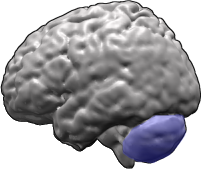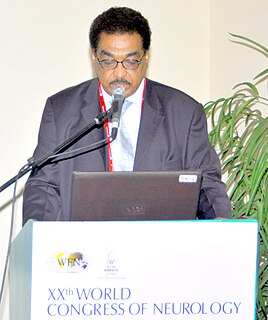Related Research Articles

Muscular dystrophies (MD) are a genetically and clinically heterogeneous group of rare neuromuscular diseases that cause progressive weakness and breakdown of skeletal muscles over time. The disorders differ as to which muscles are primarily affected, the degree of weakness, how fast they worsen, and when symptoms begin. Some types are also associated with problems in other organs.

Harvard Medical School (HMS) is the graduate medical school of Harvard University and is located in the Longwood Medical Area of Boston, Massachusetts. Founded in 1782, HMS is one of the oldest medical schools in the United States and is consistently ranked first for research among medical schools by U.S. News & World Report. Unlike most other leading medical schools, HMS does not operate in conjunction with a single hospital but is directly affiliated with several teaching hospitals in the Boston area. Affiliated teaching hospitals and research institutes include Dana–Farber Cancer Institute, Massachusetts General Hospital, Brigham and Women's Hospital, Beth Israel Deaconess Medical Center, Boston Children's Hospital, McLean Hospital, Cambridge Health Alliance, Judge Baker Children's Center, and Spaulding Rehabilitation Hospital.
The Muscular Dystrophy Association (MDA) is an American 501(c)(3) umbrella organization that works to support people with neuromuscular diseases. Founded in 1950 by Paul Cohen, who lived with muscular dystrophy, it works to combat neuromuscular disorders by funding research, providing medical and community services and educating health professionals and the general public and contributed more than $1 billion toward researching therapies and cures, helping to fund the identification of the dystrophin gene responsible for Duchenne muscular dystrophy as well as prospective treatments.

NYU Grossman School of Medicine is a medical school of New York University, a private research university in New York City. It was founded in 1841 and is one of two medical schools of the university, with the other being the Long Island School of Medicine. NYU Grossman School of Medicine is part of NYU Langone Health, named after Kenneth Langone, the investment banker and financial backer of The Home Depot.

Spinocerebellar ataxia (SCA) is a progressive, degenerative, genetic disease with multiple types, each of which could be considered a neurological condition in its own right. An estimated 150,000 people in the United States have a diagnosis of spinocerebellar ataxia at any given time. SCA is hereditary, progressive, degenerative, and often fatal. There is no known effective treatment or cure. SCA can affect anyone of any age. The disease is caused by either a recessive or dominant gene. In many cases people are not aware that they carry a relevant gene until they have children who begin to show signs of having the disorder.
Kevin P. Campbell is an Investigator for the Howard Hughes Medical Institute, UI Foundation Distinguished Professor, the Roy J. Carver Chair of Molecular Physiology and Biophysics, and head of the department; he is also professor of neurology and internal medicine at the University of Iowa.

The University of California, Los Angeles School of Medicine—known as the David Geffen School of Medicine at UCLA (DGSOM)—is an accredited medical school located in Los Angeles, California, United States. The school was renamed in 2001 in honor of media mogul David Geffen who donated $200 million in unrestricted funds. Founded in 1951, it is the second medical school in the UC system, after the UCSF School of Medicine.

The Lewis Katz School of Medicine at Temple University (LKSOM), located on the Health Science Campus of Temple University in Philadelphia, PA, is one of 7 schools of medicine in Pennsylvania conferring the M.D. degree. It also confers the Ph.D. and M.S. degrees in biomedical sciences. In addition, LKSOM offers a Narrative Medicine Program.

Eva Lucille Feldman, M.D., Ph.D., F.A.A.N., F.A.N.A. is an American physician-scientist and one of the world’s leading authorities on neurodegenerative disease. Currently, she serves as the Russell N. DeJong Professor of Neurology at the University of Michigan, as well as Director of the NeuroNetwork for Emerging Therapies and ALS Center of Excellence at Michigan Medicine. She was also recently named the James W. Albers Distinguished University Professor of Neurology.
Vanderbilt University School of Medicine is a graduate medical school of Vanderbilt University located in Nashville, Tennessee. Located in the Vanderbilt University Medical Center on the southeastern side of the Vanderbilt University campus, the School of Medicine claims several Nobel laureates in the field of medicine. Through the Vanderbilt Health Affiliated Network, VUSM is affiliated with over 60 hospitals and 5,000 clinicians across Tennessee and five neighboring states, managing more than 2 million patient visits each year. It is considered one of the largest academic medical centers in the United States and is the primary resource for specialty and primary care in hundreds of adult and pediatric specialties for patients throughout the Mid-South.

Fritz E. Dreifuss, MD was a German-born, New Zealand-educated, American neurologist and subspecialist in epilepsy based at the University of Virginia in Charlottesville, Virginia, US.
Victor Dubowitz, FRCP, Hon FRCPCH is a British neurologist and professor emeritus at Imperial College London. He is principally known along with his wife Lilly Dubowitz for developing two clinical tests, the Dubowitz Score to estimate gestational age and the other for the systematic neurological examination of the newborn.

Mary Jane Rotheram-Borus is a licensed clinical psychologist and professor with the University of California, Los Angeles, Department of Psychiatry and Biobehavioral Sciences. Rotheram is the professor-in-residence in the Semel Institute for Neuroscience and Human Behavior. She is the Director of the Global Center for Children and Families at UCLA and the former director of the Center for HIV Identification, Prevention, and Treatment Services.
Sunil Pradhan is an Indian neurologist, medical researcher and writer, known for the invention of two electrophysiological techniques. He has also described five medical signs, of which one related to Duchenne muscular dystrophy is known as Pradhan Sign, and the others associated with facioscapulohumeral muscular dystrophy (FSHD) and similar neuro diseases. The Government of India awarded him the Padma Shri, the fourth highest civilian award, in 2014 for his contributions to the field of neuroscience.

The SUNY Downstate Health Sciences University is a public medical school in New York City and one of the three components of SUNY Downstate Medical Center: University Hospital at Long Island College Hospital, SUNY Downstate at Bay Ridge, and University Hospital of Brooklyn in East Flatbush, whose staffing is provided by SUNY Downstate College of Medicine.

Charlotte Jane Sumner is an American neurologist. She is a professor in the Departments of Neurology and Neuroscience at Johns Hopkins School of Medicine. Dr. Sumner cares for patients with genetically-mediated neuromuscular diseases and directs a laboratory focused on developing treatments for these diseases. She co-directs the Johns Hopkins Muscular Dystrophy Association Care Center, the Spinal Muscular Atrophy (SMA), and the Charcot-Marie-Tooth (CMT) clinics, which deliver multidisciplinary clinical care, engage in international natural history studies, and provide cutting edge therapeutics.

Mustafa Abdalla Mohamed Salih, , is a Sudanese academic professor, scientist and pediatric neurologist. He established the first pediatric neurology specialty in Sudan and is also one of the founders of the pediatric neurology specialty in Saudi Arabia. He identified inherited neurologic diseases which were subsequently named after him. Salih Myopathy, Salih ataxia, and Bosley-Salih-Alorainy syndrome resulting from mutations in HOXA1 gene. He is also known to have led a team of scientists who proved that the extract from broad beans also known as hoarse beans had the ability to cure epilepsy spasms. Mustafa is also credited for having discovered a novel form of hereditary spastic paraplegia.

Thomas A. Rando is an American stem cell biologist and neurologist, best known for his research on basic mechanisms of stem cell biology and the biology of aging. He is a Professor of Neurology and Neurological Sciences at Stanford University School of Medicine, where he is founding director of the Glenn Center for the Biology of Aging. He is also co-founder and deputy director of the Stanford Center on Longevity, founding director of Stanford's Muscular Dystrophy Association Clinic, and Chief of Neurology at the VA Palo Alto Health Care System.
Anne Louise Coleman is an American ophthalmologist. She is a Professor of Ophthalmology in the Jules Stein Eye Institute of the David Geffen School of Medicine at UCLA and the 124th president of the American Academy of Ophthalmology.
Daniel B. Drachman is an American neurologist. He is one of the founding members of the Johns Hopkins University's Department of Neurology.
References
- ↑ "Mark Sauer Interview with Dr. Susan Perlman". members.tripod.com.
- ↑ "UCLA Physician Susan Perlman, MD". Archived from the original on June 22, 2013. Retrieved January 9, 2012.
- ↑ [ permanent dead link ]